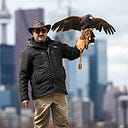AUTONOMOUS HERDING DRONES
Flocks of geese, gulls, and other birds are invading air space and are causing a real safety threat for passengers of small planes. These flocks have been the number one cause of small plane crashes in the 21rst century, and have even caused some catastrophic plane crashes in the United States as well. There was a near-miss in 2009 where a US Airways Flight hit a flock of geese and had to make an emergency landing on the Hudson River. Luckily there were no passenger fatalities, but this was a real wake-up call to the danger and potential severity of bird strikes. Approximately 17,000 bird strikes have been reported annually since 2011 and this number is expected to grow by roughly 10% each year without the intervention of a more effective method for bird control in these airspaces.
Previously, trained birds of prey or piloting drones have been flown around to eliminate flocks in airspace environments. But these methods can sometimes be unpredictable and costly. Once a flock perceives an erratic and immediate threat, they will no longer act as a flock and will begin to act individually to evade danger. For this reason, Engineers at Caltech’s Center for Autonomous Systems and Technologies came up with the idea of autonomous herding drones.
These autonomous herding drones have been designed to pose an external threat to control unwanted birds in airspace environments. Without the presence of that immediate threat, a flock can be herded as a single body, moving in a single direction, responding and reciprocating the actions of the birds closest to the external threat, and changing course accordingly.
The engineers that designed these drones specialize in autonomy and robotics. Their precise and accurate positioning reduces any chance of these birds acting individually. To determine these positions, a mathematical model of flocking dynamics was created. This model took into consideration many variables to optimize efficiency; the way flock formations are built and maintained, how threats are communicated from one bird to the next, and how these flocks respond to various threats coming from different angles. The main objective of this device is to ensure safe and effective removal of flocks from airspace environments.
This method was first tested on a flock of birds in Korea. Dozens of birds were reoriented successfully with the use of a single autonomous herding drone. But even though this method was successful with smaller flocks, the limiting factor for this method seems to be how to optimize the efficiency for use with much larger flocks of birds. The team at Caltech will be attempting to use multiple autonomous drones at once in order to deal with higher quantities of birds. So with this up-and-coming technology, there is most definitely hope for a decrease in the amount of aviation disasters due to bird strikes.
With offices across Canada and our new location in the U.S., we are here to help you deal with Pest Bird Control and avoid potential health hazards, costly damage to property, and loss of product and/or productivity (especially in the food and healthcare sectors) if pest birds are not addressed immediately.
CALL 416-HAWKEYE (416–429–5393) AND ELIMINATE YOUR PEST BIRD PROBLEM TODAY!
Source: https://www.hawkeye.ca/blog/autonomous-herding-drones
